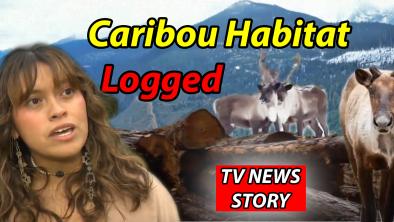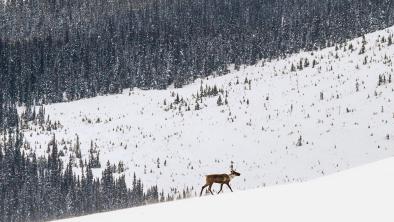B.C. approved 83 logging cut blocks in endangered caribou habitat in last six months
The Narwhal
New survey of permits granted by province highlights incongruity between treatment of forestry companies and a critically imperilled species
The B.C. government has approved dozens of new logging cut blocks in endangered mountain caribou critical habitat since May, conservation groups revealed at a Monday news conference that included renowned Canadian naturalist and artist Robert Bateman.
The 83 new logging cut blocks, the equivalent of 11 Stanley Parks in size, are in the critical habitat of B.C.’s eight most imperilled southern mountain caribou populations, found mainly along the province’s eastern border.
“The clock is ticking and caribou need protection now,” said Charlotte Dawe, a spokesperson for the Wilderness Committee, which discovered the new cut blocks approved by the B.C. ministry of forests, lands and natural resource operations, one of the two provincial ministries in charge of leading recovery efforts for the species.
“If the province was serious about the federal Species at Risk Act and about protecting caribou then they would have at least rejected the permits for these cut blocks.”
Thirty of B.C.’s 54 caribou herds are at risk of local extinction, and 14 of those herds now have fewer than 25 animals.
Dawe, along with Bateman and representatives from four other conservation groups, called on the provincial government to declare a moratorium on new development in caribou critical habitat while it works on a recovery plan to save southern mountain caribou populations.
“We are asking that the B.C. government put an immediate stop to all destructive activities in critical caribou habitat while the plan is underway,” said Dawe. “And if they fail to do this then the federal government needs to step in.”
The same eight B.C. herds facing new logging in their habitat were singled out in May by federal Environment Minister Catherine McKenna when she declared that southern mountain caribou faced “imminent threats” to their recovery and said immediate intervention was required. They include the Quintette, Kinbasket, Narraway and South Monashee herds.
If McKenna is not satisfied that B.C. has a suitable plan of action to protect endangered herds, she can ask the federal Cabinet to approve an emergency protection order under the federal Species at Risk Act.
That would allow Ottawa to make decisions that are normally within the jurisdiction of the B.C. government, including whether or not to grant logging permits.
“We wanted to see what had changed on the landscape since that big federal announcement,” Dawe told The Narwhal. “So we looked on the landscape to see how the provincial government was responding. We wanted to see if the provincial government was taking this seriously and they’re not.”
At the press conference, Candace Batycki, a spokesperson for the Yellowstone to Yukon Conservation Initiative (Y2Y), held up a hefty antler from a caribou belonging to the locally extinct Burnt Pine caribou herd in the Peace, another region where shrinking caribou herds are struggling to survive in the midst of habitat fragmented by mining, oil and gas development, logging, road-building and other disturbances.
“We’re seeing smaller and smaller herds and then they wink out,” she said.
West Moberly First Nations went to court to prevent a logging company, First Coal Corp, from mining in the Burnt Pine’s critical habitat, but a favourable court ruling came too late and the last 11 surviving members of the herd perished.
Batycki said “nothing has changed for caribou on the ground” since the B.C. government’s 2017 announcement that it would invest $27 million into caribou recovery efforts, despite a “clear scientific consensus” that habitat loss is driving the species’ rapid decline.
The only change is the dramatic decline of two more herds, including the Gray Ghost herd in the southern Selkirk mountains which is down to three animals, said Batycki, B.C. program director for Yellowstone to Yukon, which works with scientists in Canada and the U.S. to conserve one of the world’s last intact mountain ecosystems and North America’s longest wildlife corridor.
Those two herds, which are now functionally extinct, were not included in McKenna’s announcement or in the Wilderness Committee’s map of new cut block approvals.
“We have repeatedly requested that the B.C. government call a pause to create some breathing room, while putting development moratoriums in place while recovery planning proceeds,” Batycki said.
“Our pleas have fallen on deaf ears,” she said. “I had hoped that the days of ‘talk and log’ were over.”
Batycki pointed to the “expensive and drastic actions” that some communities have been forced to take in the face of what she called “government intransigence,” including an elaborate First Nations-led caribou penning project in the Misinchinka mountains in the Peace region.
Doug Donaldson, minister of forests, lands and natural resource operations, told The Narwhal his government has been “working hard” on the caribou issue since the federal government highlighted new concerns in May.
“We’re very concerned about an iconic species in B.C.,” Donaldson said. “We want to see caribou not just survive but recover.”
Donaldson said 2.2 million hectares of prime caribou habitat has already been set aside from logging. “There has been logging continuing in areas where caribou are present, but not in critical habitat areas.”
But Dawe said the new approved cut blocks are all found in critical habitat designated by the federal government.
Donaldson described a conservation agreement — one the B.C. government was compelled to pursue under the federal Species at Risk Act — as the “first of its kind in Canada.”
“We’re working diligently on a section 11 agreement with the federal government to ensure we have recovery of this species,” the minister said. Section 11 of the federal Species at Risk Act authorizes a minister to enter into a conservation agreement to protect a species in peril.
Scientists have roundly criticized a “resource document” produced by Donaldson’s ministry as part of the caribou recovery program, described by the government as a “new, made in B.C.” initiative even though recovery strategies already exist to save the antlered mammal engraved on the Canadian quarter.
“We fear that intentions to develop a ‘made in B.C.’ approach will amount to much wasted time, even as decisions are underway to degrade more prime caribou habitat,” scientists Justina Ray and scientist Chris Johnson wrote in a six-page letter to Donaldson’s ministry.
The June letter said the ministry’s discussion paper ignores scientific findings, adds “little if anything” to the probability of species recovery and has an overall approach similar to those that have failed in the past.
Asked if caribou have more time, Donaldson pointed to measures such as maternal penning, predator management and habitat restoration that are underway in the Peace region.
“Overall we’ve been taking a very aggressive approach to caribou management and it includes habitat restoration.”
Dawe said the B.C. government has come up with “caribou plan after caribou plan and consultation after consultation. But all of this will be for nothing because as we speak critical habitat is being loaded onto logging trucks.”
Eddie Petryshen, Wildsight’s conservation coordinator, said the province needs to start a captive breeding program for mountain caribou so they can be introduced back into areas where they are likely to succeed.
“Caribou have survived ice ages,” Petryshen said. “They’ve survived climatic shifts. They’ve survived fires that changed large swathes of their habitat. But they can’t seem to survive us.”
To see original article click here


